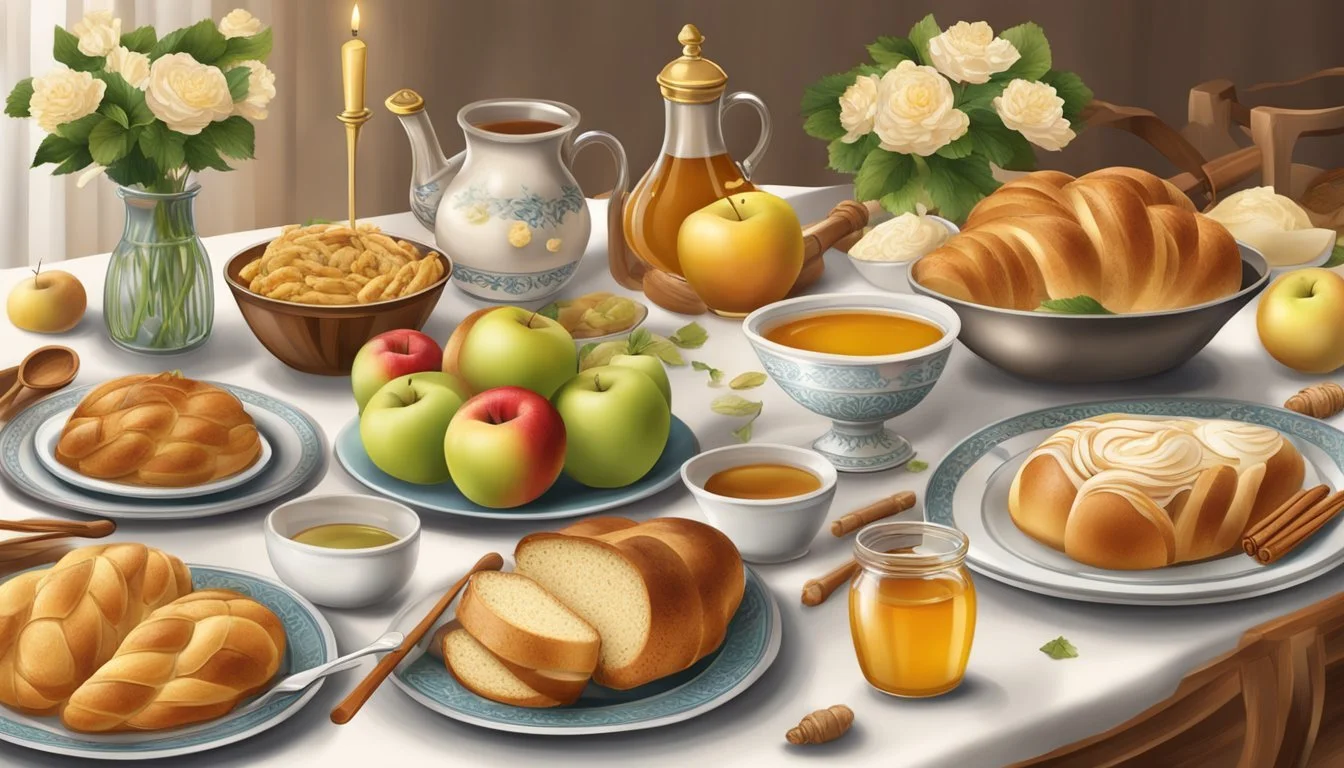10 Meal Prep Ideas for Rosh Hashanah
Festive Recipes for a Sweet New Year
Rosh Hashanah marks the beginning of the Jewish New Year, a time steeped in tradition and reflection. It ushers in the High Holy Days, a period abundant with blessings and symbolic practices integral to Jewish culture. The holiday not only invites families to gather and celebrate but also encourages looking inward and acknowledging the passing of time, making way for new beginnings.
During Rosh Hashanah, meal preparation takes on a deeply significant role, with food symbolizing the hopes for a sweet and prosperous year ahead. Kitchens become bustling centers of activity where recipes passed down through generations come to life. Each dish, from the round challah to the apples dipped in honey, carries with it a message of hope and renewal.
The meals served are a testament to the holiday's dual nature of festivity and contemplation. They are meticulously planned to incorporate both the traditional flavors that have become synonymous with the celebration and the desire to look forward with optimism. Crafting a menu that respects time-honored customs while embracing the individual tastes of the family becomes a balancing act of culinary expression and historical homage.
The Significance of Rosh Hashanah
Rosh Hashanah, the Jewish New Year, is a crucial holiday that marks the beginning of the ten-day period of introspection and repentance known as the High Holy Days or Yamim Noraim. It is a time when individuals reflect on the past year, seek forgiveness, and make resolutions for the year ahead.
During Rosh Hashanah, each person's actions, both good and bad, are believed to be scrutinized. The holiday emphasizes the power of prayer and good deeds, as individuals strive to influence the divine decree for the coming year. It's a time for asking for blessings and wishing prosperity and well-being for family and friends.
The blowing of the shofar, a ram's horn, is a key ritual. The shofar is sounded on both mornings of the holiday (except when the first day is on Shabbat) and is a call to repentance, acting as a spiritual wake-up call.
Rosh Hashanah is also closely associated with symbolic foods. Certain foods are eaten to evoke these blessings, including:
Apples dipped in honey, for a sweet new year
Round challah, representing the cycle of the year
Pomegranates, symbolizing fruitfulness
Fish heads, to express the wish to be at the head, not the tail, in the coming year
These and other foods serve as tangible reminders of the holiday's themes and the hopes for a good and prosperous year ahead. Each ingredient is steeped in tradition, infusing the holiday with layers of meaning beyond the festive meals.
Setting the Table
When preparing a table for Rosh Hashanah, one should consider creating an environment that reflects the spirit of the holiday, aiming for a setting that is both beautiful and functional. As hosts set out their finest tableware and decorate with intention, they bring the essence of Rosh Hashanah—wishing for a sweet new year—into their homes.
Table Decor and Themes
Selecting a theme for the Rosh Hashanah table often involves incorporating symbols of a sweet new year. A common approach features elements such as apples, honey, and pomegranates. Here are some tips:
Centerpieces: Vases filled with apples and pomegranates can serve as attractive and symbolic centerpieces.
Color Palette: Warm, honey-toned tablecloths and napkins can complement the holiday's motif, as they bring to mind the sweetness that is desired for the new year.
Bee Wax Candles: Utilizing bee wax candles not only adds a touch of elegance but also pays homage to bees, an important symbol of Rosh Hashanah.
Choosing the Right Utensils
The utensils at a Rosh Hashanah celebration should be in line with both the menu and the formality of the event. Consider the following:
Flatware: Opt for higher-end flatware if hosting a formal dinner. Bed Bath and Beyond carries a selection suitable for such occasions.
Dishes and Stemware: Crate and Barrel offer a range of dishes and stemware that can accommodate everything from the appetizers (What wine goes well with appetizers?) to the main course and drinks.
Serving Pieces: Ensure to have specific serving pieces for traditional foods like round challah and dishes for honey to keep with the holiday customs.
Appetizers and Starters
Rosh Hashanah meals traditionally commence with appetizers that not only stimulate the appetite but also carry deep symbolic meaning. These starters set the tone for the festivities, often incorporating sweetness to represent a prosperous year ahead, while also offering a variety of flavors and textures.
Sweet Beginnings with Honey
Honey serves as a cornerstone of Rosh Hashanah appetizers, symbolizing the wish for a sweet new year. A popular choice is to serve thinly sliced apples dipped in honey. For a twist, chefs can prepare honey-infused dishes like mini beet, cheddar, and apple tarts, highlighting the seasonal fruit in an elegant way.
Apples and Honey Plate:
Thinly sliced apples
Local honey for dipping
Optional: sprinkle of pomegranate seeds or dukkah for added flavor
Healthy Salad Options
Salads offer a fresh and healthy beginning to the meal, often featuring ingredients like carrots or pomegranate seeds. A simple yet favorite choice is a carrot salad with a honey and lemon dressing, marrying the traditional sweetness with a zesty freshness. Additionally, incorporating greens with a light vinaigrette provides balance before the hearty meal to come.
Pomegranate and Carrot Salad:
Grated carrots
Pomegranate seeds
Light honey lemon dressing
Fish Dishes as Appetizers
Fish is another traditional component, especially gefilte fish, which is customarily served as an appetizer on Rosh Hashanah. Presenting fish represents a bountiful year ahead. It can be served as is or garnished with a touch of horseradish for a piquant contrast to the sweet elements on the table.
Gefilte Fish Platter:
Gefilte fish portions
Horseradish or beet horseradish sauce
Garnish with a sprig of dill or parsley
Main Courses
Rosh Hashanah is a time for traditional flavors and dishes that have been passed down through generations. Main courses often focus on meats and symbolic ingredients, offering both richly flavored plates and lighter alternatives.
Traditional Meats
Brisket: A classic choice for Rosh Hashanah, brisket is often prepared as a sweet and sour brisket or braised brisket. The slow cooking process makes the meat tender and allows the flavors of ingredients like honey, onions, and garlic to permeate the dish.
Pot Roast Chicken: Roast chicken is another staple, with the bird typically seasoned with a blend of herbs and spices before being roasted to golden perfection.
Vegetarian and Vegan Alternatives
Vegetarian Main Dishes: Those following a vegetarian or vegan diet can enjoy alternatives such as stuffed vegetables or quinoa patties.
Lentil soup flavored with pomegranates provides a hearty option that respects the festive custom of including this fruit, which symbolizes abundance.
Pomegranate-Infused Dishes
Pomegranate Chicken: For an inventive twist, chefs incorporate pomegranates into main courses. They might glaze chicken with a pomegranate reduction for a balance of tartness and sweetness.
Pomegranate Tart: Not just an addition to desserts, a savory pomegranate tart can be the centerpiece, offering a unique blend of flavors that are both satisfying and in line with Rosh Hashanah's themes.
Side Dishes
Rosh Hashanah side dishes often feature ingredients with symbolic meanings, and the selected recipes focus on variety and taste, blending traditional flavors with contemporary cooking methods.
Potato-Based Sides
One cannot think of Jewish holiday meals (What wine goes well with holiday meals?) without the comforting presence of potato-based sides. Potato kugel is a classic, with its crispy top and soft interior. It pairs excellently with both meat and fish. Another favorite is Air Fryer Roasted Potatoes, achieving a crispy texture with less oil, signifying a healthier start to the New Year.
Classic Potato Kugel
Crispy crust
Tender inside
Air Fryer Roasted Potatoes
Healthier option
Impossibly crispy texture
Root Vegetable Medleys
Root vegetables are a cornerstone of hearty Rosh Hashanah meals. Tzimmes, a traditional stew, usually includes sweet potatoes, carrots, and sometimes prunes, embodying the sweetness hoped for in the coming year. Alternatively, dishes like an Orange Vegetable Medley with beets and carrots, or roasted cauliflower, offer a blend of savory and sweet, rich in both flavor and nutrition.
Traditional Tzimmes
Sweet potatoes and carrots
Symbolizes sweetness
Orange Vegetable Medley
Includes beets and carrots
Roasted for depth of flavor
Roasted Cauliflower
High nutritional value
Can be seasoned variously
Unique Grain Dishes
Grains are seamlessly woven into the side dishes of the holiday. For instance, farro is utilized in salads combined with crisp cabbage and sweet dates, adding chewy texture and rich flavor to the spread. Additionally, couscous can be served as a lighter alternative, often enhanced with raisins or apricots for natural sweetness and is a delightful accompaniment to the main courses.
Farro Salad with Dates
Chewy and flavorful
Contains cabbage and kale
Couscous with Raisins
Light and fluffy
Sweetened with dried fruit
Desserts and Sweet Treats
Rosh Hashanah meal preps are incomplete without the inclusion of desserts that encapsulate the essence of a sweet New Year. From honey-infused treats to baked goods and fruit-based delicacies, each dessert reflects tradition and promises a year of goodness.
Honey-Drizzled Delights
They often enjoy honey during Rosh Hashanah as a symbol of the wish for a sweet new year. Here are a couple of options for incorporating honey into your festive desserts:
Honey Cakes: A moist cake made with a blend of sweet honey, spices, and sometimes coffee to deepen the flavor.
Apples in Honey: Simple yet classic, slices of crisp apple are submerged in rich, golden honey, emphasizing the holiday's themes of renewal and sweetness.
Baked Goods
Baked desserts for Rosh Hashanah are not only scrumptious but also meaningful, with ingredients that signify prosperity and fertility. Some standout baked goods include:
Round Challah: This bread, traditionally sweetened with raisins, is baked into a round shape to symbolize the cycle of the year.
Apple Crisp: A popular dessert featuring tender baked apples with a crisp, buttery topping that is both comforting and delightful.
Fruit-Based Desserts
Fruit-based desserts (What wine goes well with fruit-based desserts?) are notable for not only their natural sweetness but also for the symbolic meanings that certain fruits carry during Rosh Hashanah. Here are ways to enjoy fruits in your desserts:
Dates Stuffed with Nuts: Dates often represent the hope to avoid enemies and misfortune, filled here with nuts for added texture and flavor.
Pomegranate Seed Garnish: Incorporate pomegranate seeds as a garnish on desserts to represent the wish for numerous blessings, akin to the numerous seeds in the fruit.
Jewish New Year Traditions
Rosh Hashanah, often referred to as the Jewish New Year, is rich with customs and religious significance. Celebrants often recognize Rosh Hashanah as a time when God is thought of as a king sitting in judgment, making decisions about the fate of every individual for the coming year.
The holiday starts on the eve, known as Erev Rosh Hashanah, when families gather to usher in the festive period with candle lighting and traditional prayers. A highlight of the celebration is the challah, which is uniquely shaped in a circle to symbolize the continuity of creation.
Traditional recipes are central to the celebration, often featuring sweet flavors that represent hopes for a sweet year ahead. Below is a list that includes common traditional foods prepared for Rosh Hashanah:
Challah Bread: Round in shape, representing the cycle of the year; often sweetened with raisins.
Apples and Honey: Dipped apples in honey to symbolize the hope for sweetness in the new year.
Fish Head: Symbolizes the expression 'to be the head and not the tail,' a wish to be leaders and not followers.
The dinner table during this Jewish holiday also typically includes:
Pomegranate: The many seeds are said to represent the many commandments that followers aspire to fulfill.
Carrots: Prepared in various dishes, carrots are symbolic due to the Yiddish word for 'increase,' echoing the wish for a prosperous year.
In addition to the delicious sweet foods and prayers for a good year, the blowing of the shofar, a ram's horn trumpet, marks a call to reflection and repentance, completing the circle of traditions that define Rosh Hashanah.
Meal Prep and Planning
Proper meal prep and planning for Rosh Hashanah can transform the daunting task of preparing a festive meal into a smooth and enjoyable process. By focusing on advanced preparation of key ingredients and employing specific cooking techniques, hosts can ensure delicious outcomes for traditional dishes like matzo ball soup and sides featuring leeks and spinach.
Advanced Preparation Tips
Leeks and Spinach: These vegetables can be cleaned and chopped in advance. For leeks, it's important to rinse out any grit between layers. Spinach should be washed and spun dry. Store them in sealed containers in the fridge for up to two days.
Matzo Ball Soup: Matzo ball mix can be made ahead and refrigerated. Doing so allows the flavors to meld and often results in a more flavorful matzo ball. However, the balls should be formed and cooked closer to serving time to maintain their texture.
Cooking Methods and Techniques
Broth for Soups: Making a rich broth can be time-consuming. Consider using a slow cooker to simmer your chicken broth overnight. The low, consistent temperature develops flavors and tender meat without needing constant attention.
Herbs such as Dill: Fresh herbs like dill should be washed and chopped close to cooking time to retain their bright color and potent flavor. Dill can be used in dishes like spinach pie to add a fresh note.
By utilizing advanced preparation tips and effective cooking methods, one can ensure the Rosh Hashanah meal is a festive celebration of the new year without the last-minute stress.
Blessings and Reflections
Rosh Hashanah, the Jewish New Year, is a time of introspection and jubilation, where traditions symbolize the hopes for a sweet and prosperous year ahead. Families gather to reflect on the year gone by and to ask for blessings for the year to come.
Blessings over Food:
Apples in Honey: Guests relish apples dipped in honey, seeking a year filled with sweetness.
Challah: They share round challah bread, signifying continuity.
Pomegranate: One consumes pomegranate seeds, with a wish that their merits increase as the seeds of the fruit.
Blessing the Festivities:
Wine: The meal often commences with Kiddush, a blessing recited over wine, honoring the holiday's sanctity.
Cranberries: While not traditional, some include cranberries in dishes as a modern twist, bringing a tart sweetness to the table, in alignment with the overarching theme of a sweet new year.
In Reflection: During Rosh Hashanah, individuals use the opportunity to reflect on their deeds and spiritual standing, often considering the metaphorical concept that humanity is judged, and that the Divine sits as a king in judgment.
In their prayers, they express the desire to be inscribed in the book of life. The holiday becomes a mirror, reflecting their hopes and actions, as they seek to reaffirm their commitments and walk a path that garners blessings in the eyes of the Divine and their community.
Closing the Feast
Rosh Hashanah, the Jewish New Year, is steeped in tradition, where foods symbolic of sweetness and prosperity are savored. As the holiday meal concludes, attention turns to post-dinner activities and preserving the feast's remnants for future enjoyment.
After-Dinner Activities
The end of a Rosh Hashanah meal can be marked by engaging in reflective or group activities. Some families might choose to sing traditional songs that honor the occasion and the hope for a sweet new year. Others may participate in sharing stories or blessings that resonate with Rosh Hashanah's themes of renewal and introspection. It is also common for individuals to exchange good wishes, often stating, "May you be inscribed and sealed for a good year."
Cleaning and Storing Leftovers
Efficiently cleaning up and storing leftovers ensures that the holiday's labor is preserved. Durable airtight containers are ideal for keeping food fresh. Honey, a staple on Rosh Hashanah for symbolizing a sweet year, should be sealed tightly to prevent stickiness and ants. Roasted meats can be sliced and stored, with quick cooling being essential to maintain food safety. Tables provide a simple way to organize leftover storage:
Food Item Storage Method Challah Wrap in plastic wrap or foil; store at room temperature. Honey Store in original container; ensure lid is tight. Roast Chicken Slice, place in airtight container; refrigerate. Cooked Vegetables Cool, transfer to containers; refrigerate. Cakes and Desserts Cover with foil or plastic wrap; refrigerate.
Utilizing these practices helps sustain the feast's delights for the days following the holiday.
Beyond the Meal
Rosh Hashanah extends beyond the dining table, encompassing various activities and preparations that reflect the essence of the Jewish New Year. These traditions are rooted in reflection, prayer, and actions aimed at securing blessings and prosperity for the year ahead.
Rosh Hashanah Activities
Tashlich: This is a customary practice where individuals to go to a flowing body of water and cast away breadcrumbs, symbolizing the casting off of the previous year's sins. It is a physical manifestation of one’s intent to purge past mistakes and start anew.
Shofar Blowing: A central observance is the sounding of the shofar, a ram's horn, which serves as a call to reflection and penitence. This act is traditionally performed in the synagogue during the prayer service.
Preparing for Yom Kippur
Reflection: The ten days starting with Rosh Hashanah and ending with Yom Kippur, known as the Days of Awe, are a time of deep personal and communal introspection. Individuals often examine their actions over the past year and seek forgiveness from those they may have wronged.
Fasting and Prayer: Yom Kippur is a day of fasting and intensive prayer, considered the most solemn day of the Jewish year. Preparations during Rosh Hashanah involve not only physical abstinence but also mental readiness for the holiness and austerity of the day.









